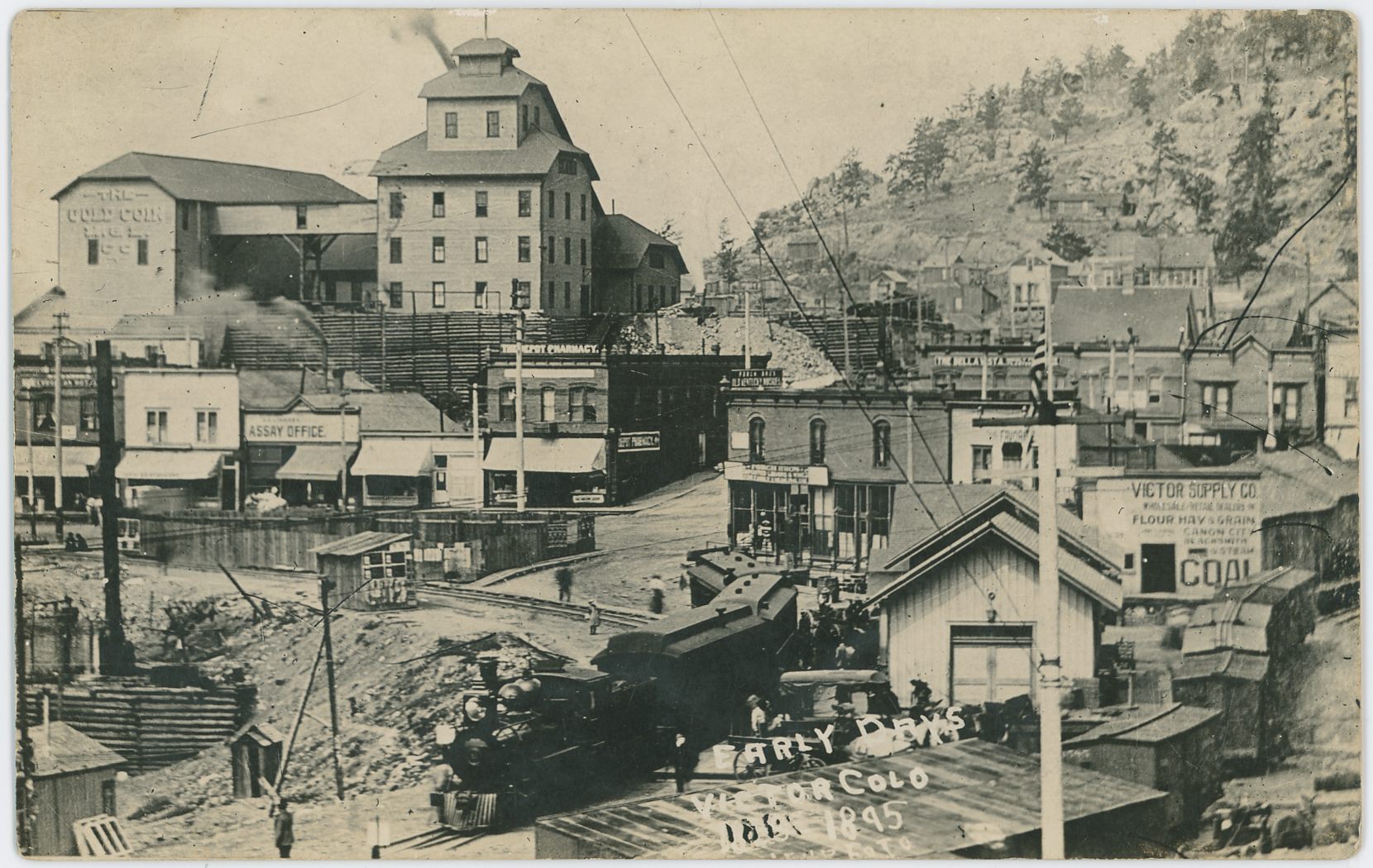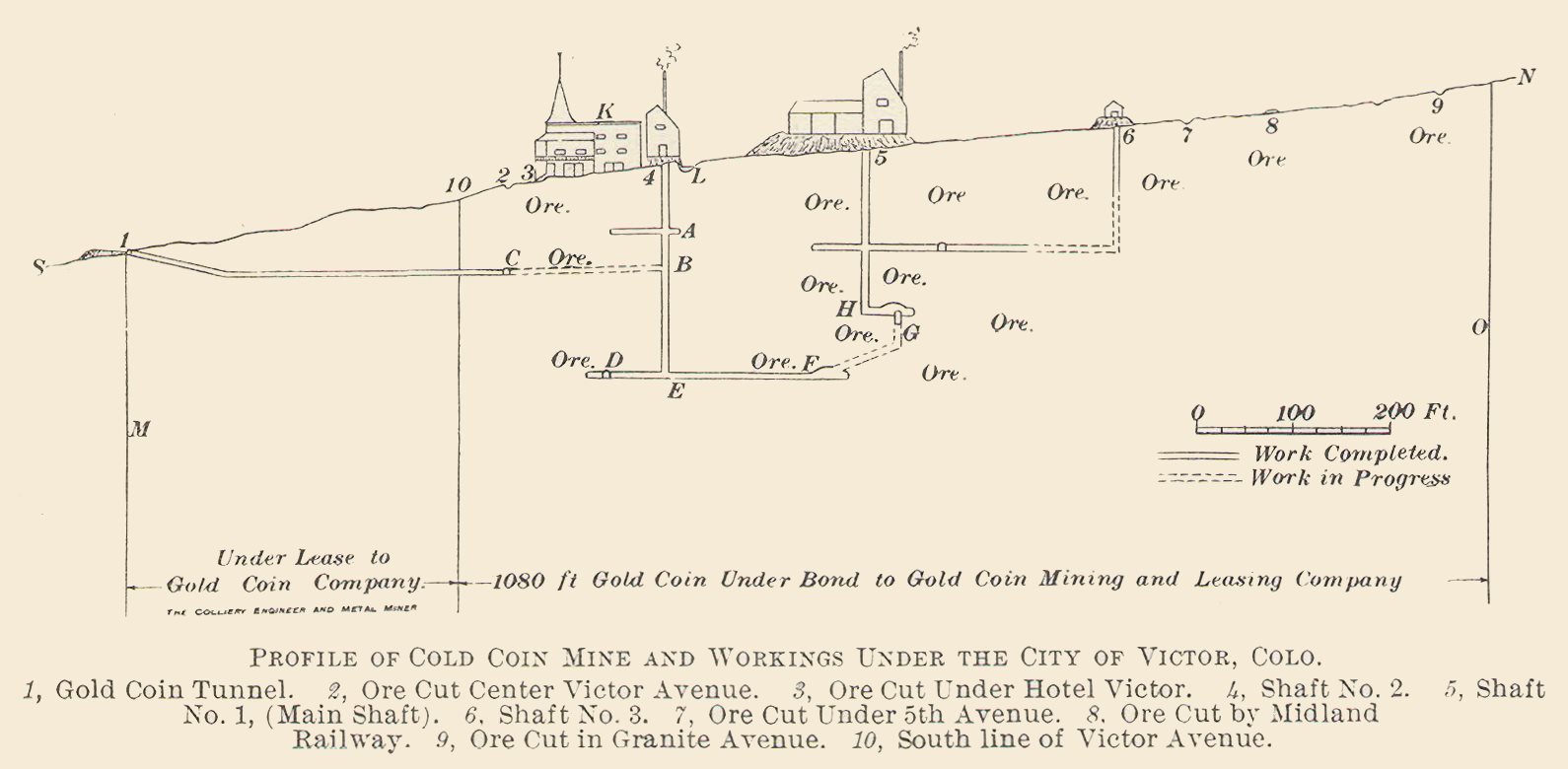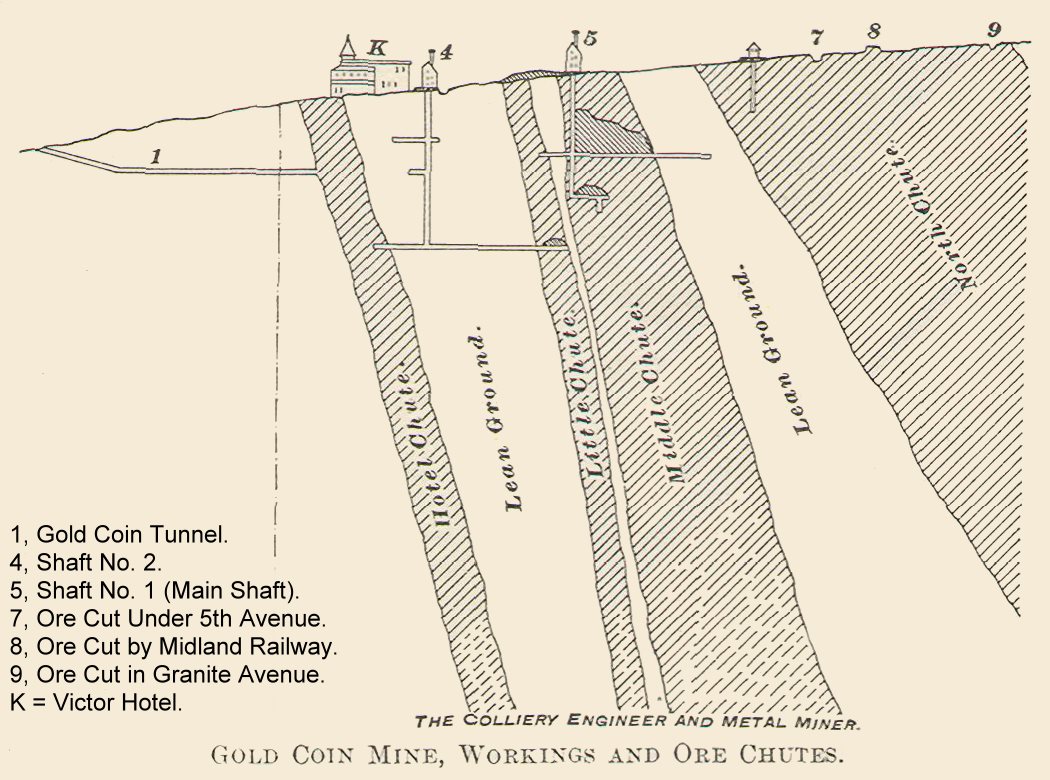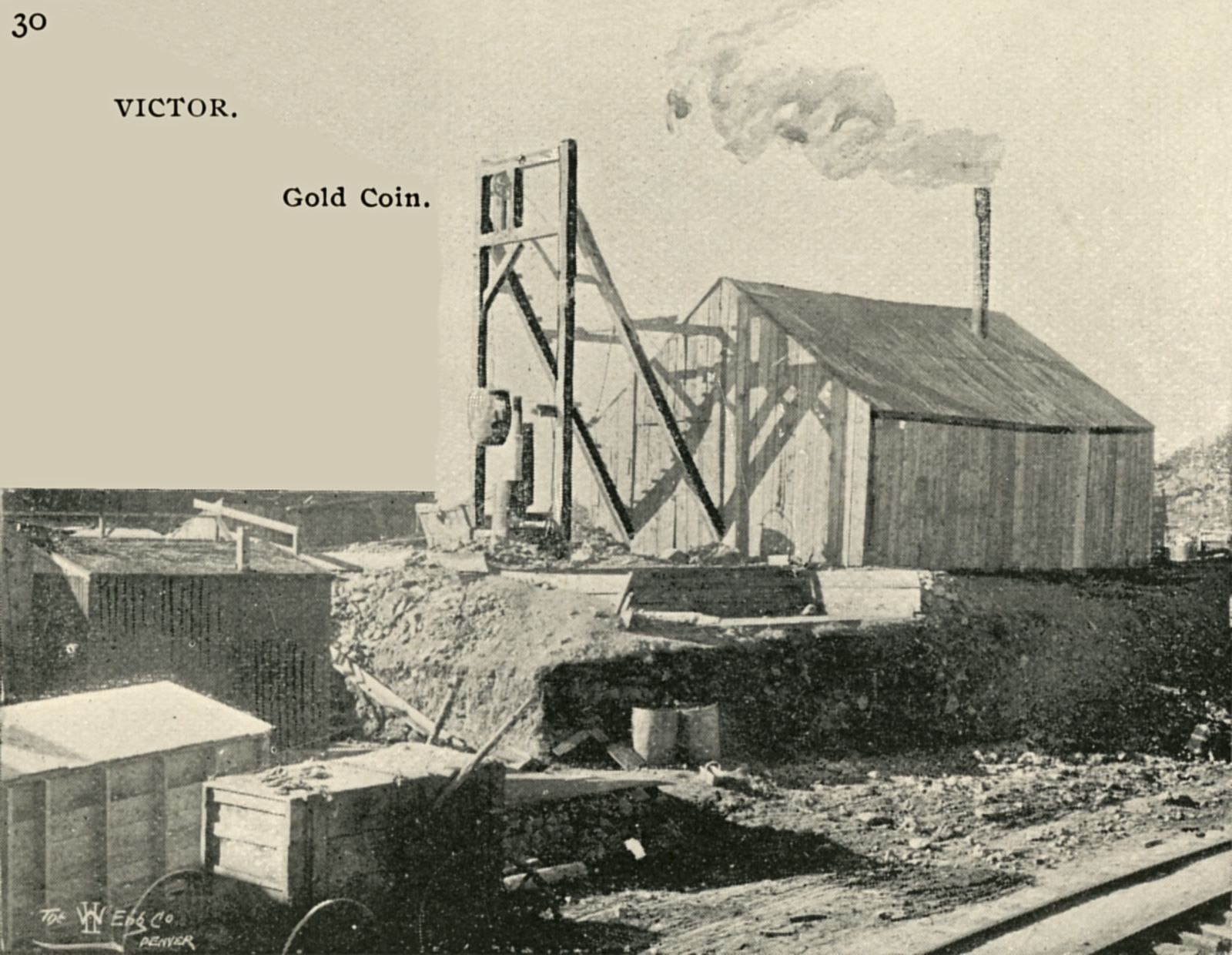-> My Collection; No source to show as I've not shared the Mining Journal as an album.
But, here is a link to first page on Hathi Trust Digital Library website.
December, 1896 (page 210->211)
Source had no images, only two sketches/drawings, so I used a couple of images from my collection.
There is no saying now-a-days where we may or not find gold. It may be in digging a well or the foundation of a house or in a new railway cut. In the present instance a most valuable vein which has been developed into a noted mine was struck in digging the foundations of the leading hotel in Victor town, and the outcrop of the vein is plain for everyone to see and examine on the bank below the hotel and in the streets of the town.
Squaw Mt., close to the town of Victor, unlike the majority of the formations of Cripple Creek, is of solid coarse reddish granite containing very large pink crystals of orthoclase feldspar which often stand out conspicuously from the matrix of the rock giving it a rugged appearance. This granite is here and there traversed by narrow dykes of a finer grained eruptive red granite, and also locally by narrow dykes of phonolite.
For a long time, the granite formation being unpopular, but little was done to investigate what the mountain might contain; later however, prospectors discovered that the mountain was traversed by a series of more or less parallel fissures or cleavage planes having a general north and south direction.
Mines opened on these cracks found rich ore in the crevices on sandy and gouge matter, at times mixed with purple fluorspar and here and there with pockets of phonolite, showing apparently that the steam and solfataric agencies that invaded the other parts of the Cripple region, had also ascended in less violent forms through the cleavage planes and narrow fissures of Squaw Mt. On one of these planes a mine called the Home vein, just west of Victor, has for a long time been working successfully.
The Midland railroad also, that made a general circular cut around the base of the mountain, showed at intervals several white looking phonolite dykes, some of which, like the Dead Pine and others, have been successfully worked for ore.
Mr. Woods, in digging the foundations for his hotel, uncovered a series of parallel vertical cracks in the granite showing some rusty material. Assays were taken of this and found to run quite high in gold, showing the importance of assaying anything that looks at all likely. To an inexperienced observer nothing more unpromising could be seen than the few rusty seams congregating in a zone a few feet in width, in the bank forming the foundation of the hotel.
No pyrite, no visible ore, no phonolite even, nothing but a few rusty parallel cracks forming what is quite common in Cripple Creek a shearing zone. This zone, however, for 16 feet in length and 10 to 16 inches in width, was found to assay from $24 to $200 in one place. According to Mr. W. Weston, consulting engineer for the Gold Coin, 16 inches assayed $128 and in the vein now exposed in the street under the hotel he reports that a 6-inch streak gave $202, a 3-inch $600.
About 800 feet north of this the Midland railway cut again exposed the ore deposit, showing similar characteristics and assaying $30 on the surface. Still further on, at a street corner, another similar exposure showed $39. Thence, going north, we have no definite exposures, but judging from the course of the vein, it passes up a depression in the hill between Squaw Mt. and Battle Mt. near the line where the main volcanic breccia and phonolite eruptions begin, an area characterized by a pathway of many veins and mineralized dykes and cross-dykes, upon some of which quartz mines are in progress, such as the Dead Pine, the Hallet and Hamburg, Ithaca and Mohican. The course of the vein would carry it about 50 feet west of the Mohican shaft and about the same distance east of the Hallet and Hamburg. In the latter mine, they claim lately to have struck it.
The following is Mr. Weston's concise account:
Pay ore has been found in surface openings along the outcrop of the vein in six different places—in the street under the Victor Hotel, on the site of the present No. 1 shaft, and at points A, B, C and D, as shown on the accompanying profile sketch of the property. These were taken at the points indicated, and represent a total along the course of the vein of 1,000 feet and, as nearly as I can estimate, ore chutes of a total length of six hundred feet along the course of the vein. Samples were taken and assayed as follows:
| VALUES ON SURFACE. | ||
|---|---|---|
| Point A | Six inches | $ 29.00 |
| Six inches | 46.00 | |
| Total twelve inches wide. | ||
| Point B | Eight inches | 37.00 |
| Three inches | 60.00 | |
| Total eleven inches wide. | ||
| Point C | Six inches | 22.00 |
| Twelve inches | 102.00 | |
| Total eighteen inches wide. | ||
| Point D | Two inches | 18.00 |
The average width was eleven inches, and the average value forty-five dollars. These A, B, C and D represent what is known as the "North Chute."
In digging the foundation for the Victor Hotel, ore was found for sixteen feet in length, and ten to sixteen inches in width, assays of which varied from $24 to $200; in one place sixteen inches assaying $128. In the vein now exposed in the street, under the hotel assays of a six-inch streak gave $202, and a three-inch streak $600.
So much for surface values. Underground, ore chutes for a total length along the course of the vein for two hundred and twenty-five feet, have been proved, and the largest, the North chute, estimated to have a length of four hundred feet, has not yet been entered.
From the very small amount of ground stoped in No. 1 shaft, as shown on the accompanying sketch, there has been extracted and sold one thousand tons of ore of an average value of $38.50 per ton in gold. The separate averages of this ore are about $30 per ton from the first level, and $50 per ton from the second level, showing a rapid increase in values as depth has been gained.
In a crosscut from the third level of No. 2 shaft, the edge of the chute, already referred to as having been found under the hotel at the surface, has been cut, and from this point three carloads of ore have been shipped, which averaged $35.
The little ore chute under the dump, which is about twenty-five feet in length, has also been reached in this level. On the surface, this was only three feet thick in the best place, while where it is struck at two hundred feet in depth, it is six feet thick in the thickest place. This chute on the surface ran $6 to $40 by assay; at two hundred feet deep in the widest place, five inches of ore yielded $150 per ton, and five feet six inches wide, yielded $24 per ton, both by actual shipments.
Between this little ore chute and the hotel ore chute there is apparently two hundred and forty feet of lean ground, but no cross-cutting has been done, and it is quite possible that when cross-cuts have been driven east and west at this point, other ore chutes will be discovered.
As already stated, the average width of the ore in the surface openings, is eleven inches. The width of the ore in the first level in the No. 1 shaft is from two to five feet; the width in the second level from two to eight feet. In the small chute under the dump, which is about twenty-five feet in length, it increased in width from three feet on the surface to six feet in the thickest place at the bottom, this showing a great increase in width as depth is gained.
The foregoing shows that in the short space of four months, there has opened up what bids fair to be one of the great gold mines, which have caused the fame of Cripple Creek to be worldwide. The ore has increased in width and gold values with depth ; has been opened up to a depth of two hundred feet below the surface ; is being mined from three separate chutes, which will shortly be increased to four, and ore is being extracted from two different shafts.
The mine is dry; the ventilation perfect; the rock easily broken, and ore extracted cheaply. The gold values are readily extracted by the cyanide process at a cost per ton at the mill of $7.50 to $8.50 per ton, including railroad freight. The mine is in the heart of a town, with two lines of railway crossing the property; and, with the present economical and scientific management, I do not see that much remains to be desired.
From the little beginnings we see that an important mine has been opened.
The developments illustrate a very characteristic feature of Cripple Creek ore deposits; that is, the occurrence of ore not in continuous lateral bodies, but in more or less vertical sheets with comparatively barren intervals between, as if the ore-bearing solutions had concentrated their forces along certain zones and but little affected the others. So a man may have a claim on a certain vein, or extension of a vein, that may be wholly barren, whilst in the adjoining claim the ore is in full force.



